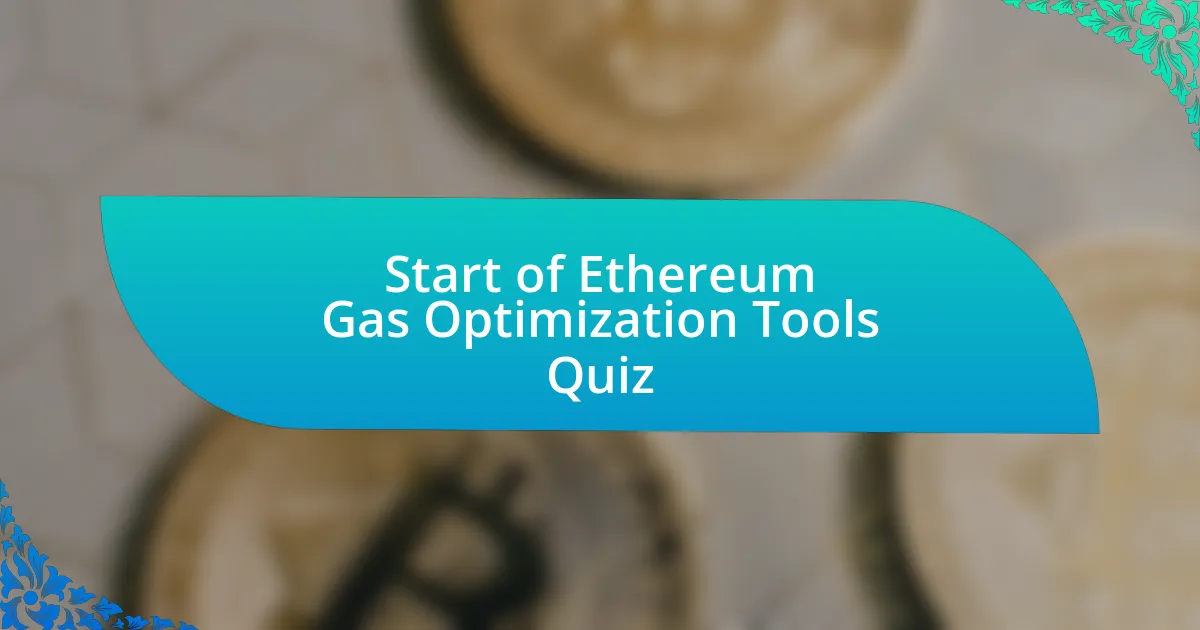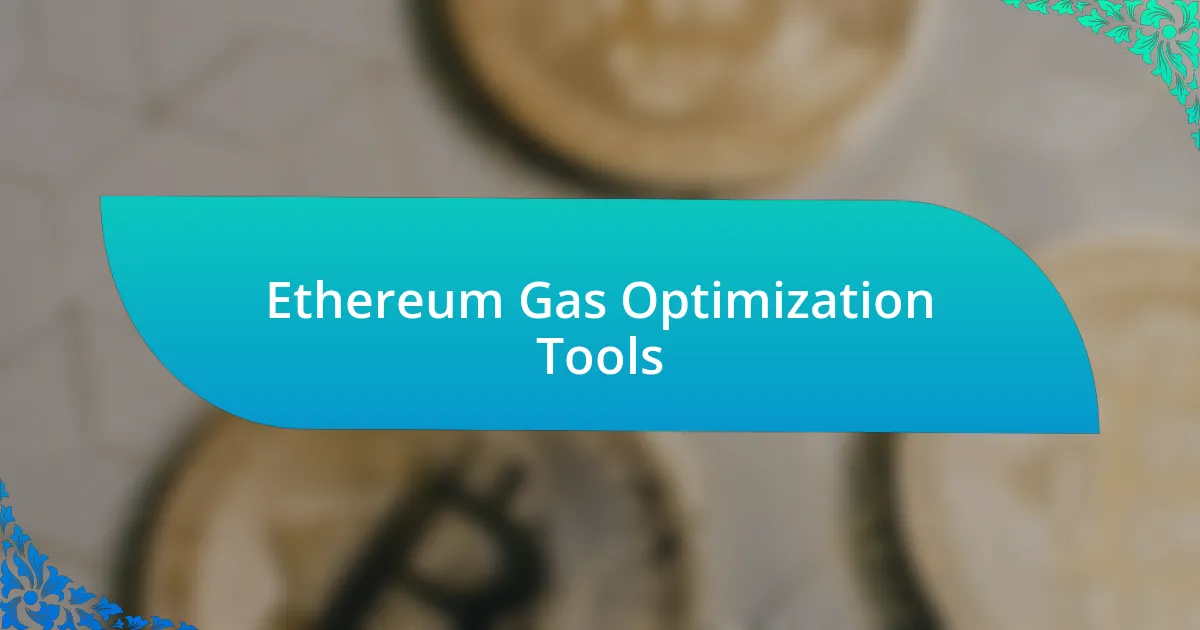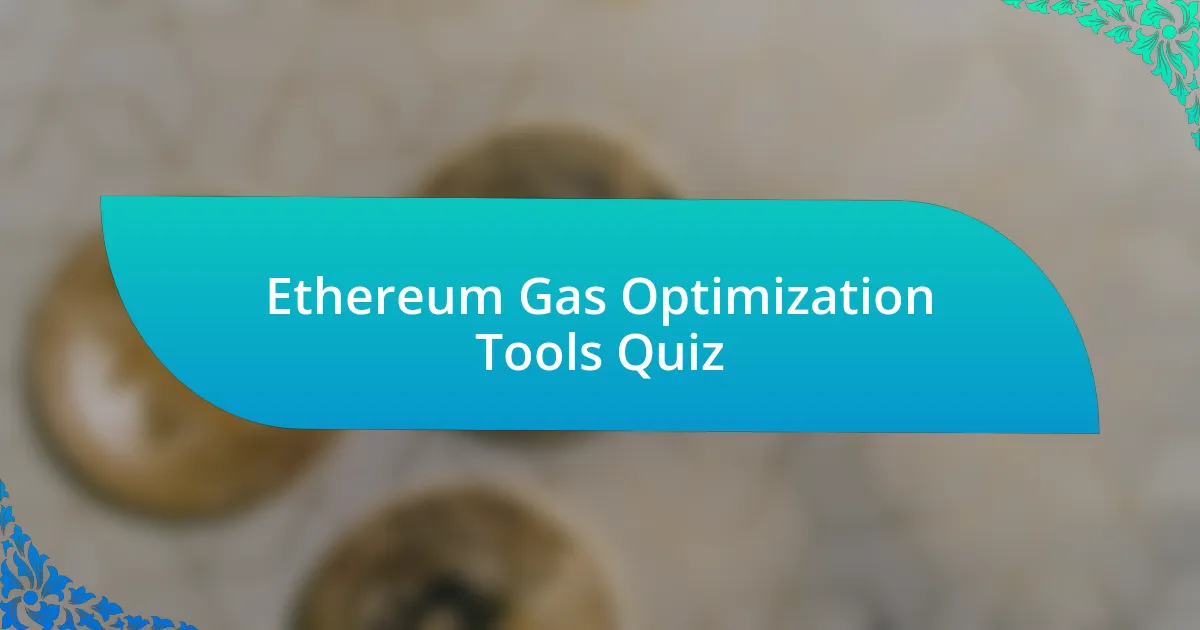
Start of Ethereum Gas Optimization Tools Quiz
1. What is the primary purpose of gas tools in the Ethereum ecosystem?
- To efficiently manage gas fees and optimize transaction costs.
- To create and deploy smart contracts effortlessly.
- To increase network speed and reduce latency.
- To enhance the visual interface of blockchain networks.
2. Which tool is known for its real-time tracking and analysis of gas prices across different blockchain networks?
- Moralis
- Etherscan
- Blocknative
- Tenderly
3. What is the name of the tool that provides a gas estimator for Ethereum transactions?
- Etherscan Tracker
- Blocknative Gas Estimator
- Tenderly Estimator
- Moralis Gas Monitor
4. Which tool is used for profiling gas usage in smart contracts?
- Truffle Suite
- Remix Studio
- Hardhat Network
- Tenderly Gas Profiler
5. What is the name of the platform that lists top gas tools for Web3 development?
- Uniswap
- Coinbase
- OpenSea
- Moralis
6. How do gas optimization techniques help in minimizing gas costs within smart contracts?
- By using specific coding patterns and optimizations.
- By avoiding the use of external libraries entirely.
- By increasing the number of transactions processed.
- By limiting the number of smart contracts created.
7. What is the difference between storage and computational costs in smart contract design?
- Storage costs are associated with transaction fees, while computational costs are linked to data retrieval.
- Storage costs indicate how many transactions can be processed, while computational costs reflect the size of the smart contract.
- Storage costs refer to the space required to store data, while computational costs refer to the resources needed to perform operations.
- Storage costs involve the resources needed to perform operations, while computational costs refer to the space required to store data.
8. How can you ensure accurate gas cost estimation before deploying a smart contract?
- By verifying gas costs only after the contract is live.
- By using reliable methods such as gas estimation tools and historical data analysis.
- By randomly guessing the gas prices based on previous experiences.
- By deploying the contract without any prior analysis.
9. What is the role of mappings in reducing gas costs in Solidity smart contracts?
- Mappings reduce gas costs by directly accessing data without needing to iterate through arrays.
- Mappings have no effect on gas costs as they work the same as arrays.
- Mappings increase gas costs by requiring more computations.
- Mappings reduce gas costs by storing data in multiple locations.
10. How do constants and immutable variables affect gas costs in Solidity smart contracts?
- They contribute to higher computational costs in smart contracts.
- They increase storage requirements, raising gas costs related to operations.
- They do not consume storage space, reducing gas costs associated with storage operations.
- They have no impact on gas costs within Solidity smart contracts.
11. What is the impact of using the `–optimize` option in the Solidity compiler on gas usage?
- It performs several hundred runs to streamline the code and significantly reduce gas usage.
- It optimizes gas fees for only external calls.
- It doubles the cost of all transactions made by the contract.
- It has no effect on gas usage and merely formats the code.
12. What is the average gas saving achieved by substituting arrays with mappings in Solidity smart contracts?
- 50% on average.
- 75% on average.
- 93% on average.
- 100% on average.
13. How does making a function external in Solidity affect gas efficiency?
- It allows accepting arrays from calldata, making it more gas-efficient when dealing with large arrays.
- It limits the amount of data that can be processed in transactions.
- It increases gas costs by requiring more computation on the blockchain.
- It has no effect on gas efficiency for external calls.
14. What is the impact of optimizing unused variables on gas usage in Solidity smart contracts?
- It increases gas costs by 0.3% per transaction.
- It saves approximately 0.3% gas units per call.
- It has no effect on gas usage at all.
- It saves around 1.5% gas units per function.
15. What is the primary benefit of using the Blocknative Gas Estimator?
- It increases block confirmation times.
- It offers discounts on transaction fees.
- It provides real-time gas price tracking and analysis.
- It automatically executes transactions.
16. How does the Tenderly Gas Profiler help in optimizing gas usage?
- It automates the deployment of gas-efficient smart contracts.
- It predicts future gas prices for transactions on the blockchain.
- It profiles gas usage in smart contracts to identify areas for optimization.
- It compiles smart contracts to reduce their initial gas costs.
17. What is the role of Etherscan in gas optimization?
- Etherscan
- Metamask
- Remix
- Infura
18. What are some common gas optimization techniques for Ethereum smart contracts?
- Increasing loop iterations for data access.
- Using mappings, constants, and immutable variables.
- Ignoring unused variables in code.
- Using dynamic arrays for all storage needs.
19. How does the use of mappings over arrays affect gas usage in Solidity?
- It increases gas costs by requiring more complex data structures.
- It has no impact on gas usage and performs the same as arrays.
- It uses more storage, thus leading to higher gas fees.
- It reduces gas usage by avoiding the need to iterate through all elements in an array.
20. What is the average gas saving achieved by using constants and immutable variables in Solidity smart contracts?
- 30%
- 70%
- 50%
- 10%
21. What is the impact of making a function external on gas efficiency in Solidity?
- It has no effect on gas efficiency in any case.
- It saves approximately 0.3% gas units per call by allowing the acceptance of arrays from calldata.
- It makes all function calls consume double the gas units.
- It increases gas costs by requiring more computation on large datasets.
22. How does the use of the `–optimize` option in the Solidity compiler streamline code and reduce gas usage?
- It simplifies the syntax of the code without changing its functionality.
- It compiles code in a single run to maximize efficiency and speed.
- It performs several hundred runs to streamline the code and significantly reduce gas usage.
- It adds additional checks to ensure code security and integrity.
23. What is the role of gas estimation tools in ensuring accurate gas cost estimation before deploying a smart contract?
- They only track historical gas prices without analysis.
- They are used solely for debugging smart contracts.
- They provide reliable methods for accurately estimating gas costs.
- They automate the deployment of smart contracts directly.
24. What is the primary benefit of using the Tenderly Gas Profiler in optimizing gas usage?
- It profiles gas usage in smart contracts to identify areas for optimization.
- It allows unlimited gas usage in transactions.
- It automatically lowers gas fees for every user.
- It reduces transaction speeds for all smart contracts.
25. How does the Blocknative Gas Estimator help in optimizing gas usage?
- It requires manual adjustments to gas limits for each transaction.
- It provides real-time gas price tracking and analysis.
- It generates random gas prices for better estimation.
- It allows for delayed transaction processing to save costs.
26. What are some common pitfalls in gas optimization that developers should avoid?
- Hardcoding values in contracts
- Increasing function complexity
- Using unnecessary loops
- Ignoring mapping types
27. What is the impact of using arrays versus mappings on gas usage in Solidity smart contracts?
- It requires more storage space, thus increasing gas costs.
- It reduces gas usage by avoiding the need to iterate through all elements in an array.
- It makes no difference in gas consumption at all.
- It increases gas usage due to extra complexity.
28. How does the use of constants and immutable variables affect gas costs in Solidity smart contracts?
- They require additional computations, increasing gas expenses.
- They increase execution speed but do not affect gas costs.
- They consume more resources than regular variables, raising costs.
- They do not consume storage space, reducing gas costs associated with storage operations.
29. What is the average gas saving achieved by optimizing unused variables in Solidity smart contracts?
- About 1.5% gas units per call.
- Roughly 5% gas units per call.
- Approximately 0.3% gas units per call.
- Around 10% gas units per call.
30. What is the primary benefit of using the `–optimize` option in the Solidity compiler?
- It performs several hundred runs to streamline the code and significantly reduce gas usage.
- It increases the size of the compiled contract and enhances security.
- It disables all optimizations and results in larger bytecode.
- It requires more memory during compilation, slowing down the process.

Quiz Successfully Completed!
Congratulations on completing the quiz on Ethereum Gas Optimization Tools! We hope you found the experience both enjoyable and informative. By exploring this topic, you have likely deepened your understanding of how Ethereum transactions work and the importance of gas fees in smart contracts. Each question was designed to enhance your knowledge and analyze different strategies for optimizing these costs.
Throughout the quiz, you may have discovered various tools and techniques to help reduce gas fees, thereby making your transactions more efficient. Learning about features like batch processing, gas limit adjustments, and gas tokens can significantly impact how you interact with the Ethereum network. Optimizing gas usage is not just about saving money; it’s about enhancing the overall user experience on the blockchain.
If you’re eager to expand your knowledge further, we invite you to check the next section on this page. There, you’ll find in-depth information about Ethereum Gas Optimization Tools that will help you navigate the complexities of gas fees. Stay curious and keep learning about the tools that can empower your journey in the Ethereum ecosystem!

Ethereum Gas Optimization Tools
Understanding Ethereum Gas
Ethereum gas refers to the unit that measures the computational work required to execute operations on the Ethereum network. Each transaction or smart contract execution consumes gas. Gas fees are paid in Ether and fluctuate based on network demand. Increased usage often results in higher fees, creating a need for gas optimization. Understanding gas dynamics is crucial for developers and users to minimize costs and enhance transaction efficiency.
The Importance of Gas Optimization
Gas optimization minimizes transaction costs and enhances the performance of smart contracts. High gas fees can deter users and limit network growth. Efficient use of gas ensures that more transactions can be processed, improving overall network functionality. Tools that optimize gas can analyze and reduce gas consumption in smart contracts. This leads to cost savings and encourages broader adoption of Ethereum applications.
Types of Gas Optimization Tools
Gas optimization tools vary but generally fall into two categories: analysis tools and deployment tools. Analysis tools assess smart contracts for inefficiencies using simulations and estimations. Deployment tools optimize the actual transaction process, adjusting parameters to reduce fees. Examples include gas estimators and performance analyzers that provide insights to developers for optimizing code.
Popular Ethereum Gas Optimization Tools
Common tools for gas optimization include Remix, Hardhat, and Gas Station Network. Remix allows developers to test, debug, and deploy smart contracts while analyzing gas costs. Hardhat offers a local Ethereum network and built-in testing features, promoting efficient development cycles. Gas Station Network provides real-time gas price insights, helping users select optimal transaction times.
Techniques for Gas Optimization
Several techniques can enhance gas efficiency in smart contracts. Using shorter data types reduces storage requirements, lowering gas costs. Code optimization, like consolidating functions, also minimizes complexity and expenses. Furthermore, avoiding redundant calculations and utilizing libraries can cut gas usage. Implementing these strategies effectively can lead to significant savings in gas fees over time.
What are Ethereum Gas Optimization Tools?
Ethereum Gas Optimization Tools are software solutions designed to help users minimize transaction fees when interacting with the Ethereum blockchain. These tools analyze gas prices and transaction complexity, leading to more efficient contract execution. For example, tools like GasNow and EthGasStation provide real-time gas price data, enabling users to choose optimal times for executing transactions to save costs.
How do Ethereum Gas Optimization Tools work?
Ethereum Gas Optimization Tools operate by collecting and analyzing data related to gas prices and network congestion. They utilize algorithms to suggest the best gas prices for transactions. Tools often automate the process of setting gas fees when submitting transactions, ensuring that users pay only what is necessary. Additionally, they may provide insights based on historical data to predict future gas price trends, helping users plan their transactions strategically.
Where can you find Ethereum Gas Optimization Tools?
Ethereum Gas Optimization Tools can be found on various platforms including websites and browser extensions. Popular examples include Etherscan, which features a gas tracker, and browser wallets like MetaMask, which incorporate gas fee estimation tools. Many decentralized finance (DeFi) protocols also provide built-in gas optimization features for their users.
When should you use Ethereum Gas Optimization Tools?
You should use Ethereum Gas Optimization Tools whenever you are planning to execute a transaction or deploy a smart contract on the Ethereum network. Using these tools is particularly beneficial during periods of high network congestion, where gas prices can fluctuate dramatically. By utilizing these tools, users can ensure they are paying the most cost-effective rates for their transactions at any given time.
Who benefits from Ethereum Gas Optimization Tools?
Developers, traders, and everyday users of the Ethereum network benefit from Ethereum Gas Optimization Tools. Developers can save on deployment costs, while traders can minimize fees during transactions. Additionally, individual users benefit from understanding gas fees, which enhances their engagement with decentralized applications and services on the Ethereum blockchain.

